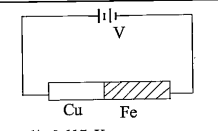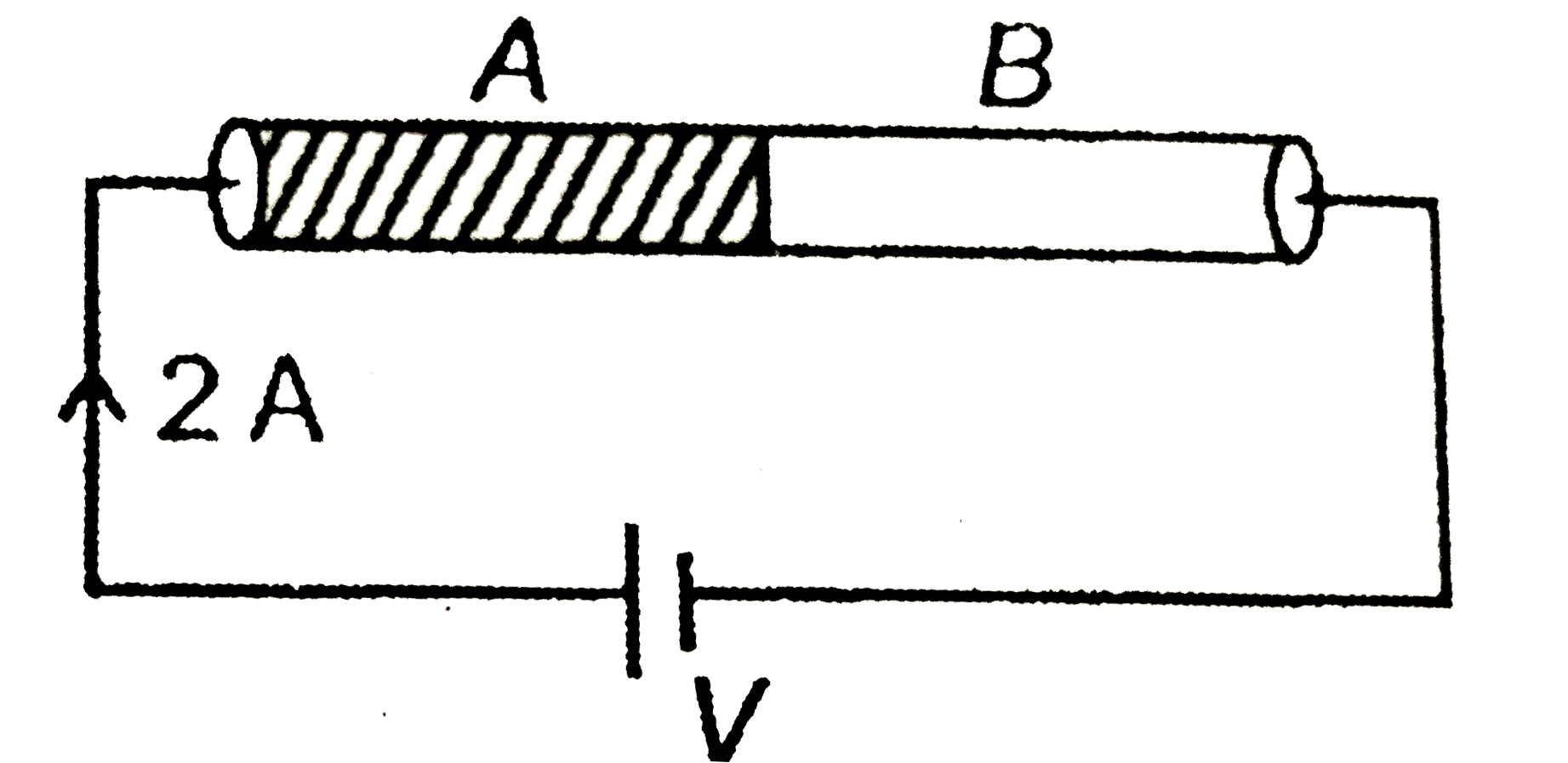Two rods are joined end to end as shown. Both have a cross-sectional area of0.01cm2. Each is 1 m long. One rod is a copper with resistivity of1.7x10−6 ohm -centimetre, the other is of iron with a resistivity of 10^-5 ohm-centimeter. How much voltage is required to produce a current of 1 ampere in the rods?
 Solution in Tamil
Solution in Tamil
0.117 V
0.00145 V
0.0145 V
1.7×10−6 V
Step by step video & image solution for Two rods are joined end to end as shown. Both have a cross-sectional area of 0.01 cm^2. Each is 1 m long. One rod is a copper with resistivity of 1.7x10^-6 ohm -centimetre, the other is of iron with a resistivity of 10^-5 ohm-centimeter. How much voltage is required to produce a current of 1 ampere in the rods? by Physics experts to help you in doubts & scoring excellent marks in Class 12 exams.
Updated on:21/07/2023Topper's Solved these Questions
Similar Questions
Nickel shows ferromagnetic property at room temperature. If the temperature is increased beryond Curie temperatue,then it will show
View SolutionThe work function of a surface of a photosensitive material 6.2eV . The wavelength of the incident radiation for which the stopping potentials is 5V lies in the:
View SolutionA copper rod of length 20cm and cross-sectional area 2mm2is joined with a similar aluminium rod as shown in figure .Find the resistance of the combination between the ends, Resistivity of copper =1.7×10−8(Ω)mand that of aluminium=2.6×10−8(Ω)m.

View SolutionThree rods of copper, brass and steel are joined together to form T shape as shown in figure. The cross sectional area of each rod is 4cm^(2) the end of copper rod is maintained at 10^(@)C and the ends of brass and steel rods at 0^(@)C assume there is no loss of heat to surrounding. What is temperature of junction point A in .^(@)C
View SolutionTwo rods of different materials having differnet lengths and same cross sectional areas are joined end to end in a straight line. The free ends of this compound rod are maintained at different temperatures The temperature gradient in each rod will be .
View SolutionTwo rods are joined end to end, as shown. Both have a cross-sectional area of 0.01 cm^(2) . Each is 1 meter long. One rod is of copper with a resistivity of 1.7 xx 10^(–6) ohm-centimeter, the other is of iron with a resistivity of 10^(–5) ohm-centimeter. How much voltage is required to produce a current of 1 ampere in the rods?
View SolutionA copper rod of length 20 cm and cross-sectional area 2 mm^(2) is joined with a similar aluminium rod as shown in Fig. 4.6. Find the resistance of the combination between the ends. Resistivity of copper =1.7xx10^(-8) Omega m and resistivity of aluminium =2.6xx10^(-8) Omega m.
View SolutionTwo rods having equal lengths and equal cross-sections but different specific resistances rho_(1)" and "rho_(2) are joined at one end as shown in the figure given above. What is the effective specific resistance of the combination ?
View Solutionलोहे की एक छड़ की लम्बाई 4 मीटर तथा अनुप्रस्थ - परिच्छेद का क्षेत्रफल 2 सेमी2 है यदि लोहे का विशिष्ट प्रतिरोध 10×10−6 ओम - सेमी हो , तो छड़ का प्रतिरोध कितना होगा ?
View SolutionA magnetizing field of 5000 A/m produces a magnetic flux of 5 xx 10^(-5) Wb in an iron rod of 0.5 cm^(2) area of cross-section. The permeability of the rod is (in Wb A^(-1) m^(-1) )
View SolutionResistivity of copper is 1.76×10−6Ω.cm. Determine the resistance of a copper rod having length 10 cm and cross sectional area 1cm2.
View SolutionTwo metal rods are joined end to end, as shown in the figure . Both have same cross sectional area of 10−6m2 and each rod is 1m long. The rod A has electrical resistivity of 2×10−6Ω cm and B has electrical resistivity of 10−5Ωcm . The voltage V required of produce current of 2A in the rods is

View Solutionएक बेलनाकार धातु (ताँबे) की छड़ की लम्बाई 1 सेमी एवं त्रिज्या 2.0mm है। छड़ के सिरों पर 120V विभवान्तर आरोपित करने पर छड़ में प्रवाहित धारा का मान ज्ञात कीजिये। (ताँबे की प्रतिरोधता 1.7×10−8Ωm है)
View Solutionएक w1 भार की छड़ का एक सिरा एक दिवार से लटका है | उसके दूसरे सिरे पर w2 भार लटका है | छड़ की अनुप्रस्थ काट का क्षेत्रफल A है, छड़ के मध्य बिन्दु पर प्रतिबल होगा
View SolutionA composite rod is made by joining a copper rod, end to end, with a second rod of a different material but of same cross-section. At 25∘C, the composite rod is 1 m in length of which the length of the copper rod is 30 cm. At 125∘C the length of the composite rod increases by 1.91 mm. The coefficient of linear expansion of copper is α=1.7×10−5∘C−1 and that of the second rod is β=n×10−5∘C−1. Find the value of n.
View SolutionTwo rods are joined end to end. Both have a cross - sectional area of 0.01 cm^(2) . Each is 1 meter long . One rod is a copper with a resistivity of 1.7 xx 10^(-6) ohm- centimeter ,the other is of iron with a resistivity 10-5 ohm-centimeter. How much voltage is required to produce a current of 1 ampere in the rods ?
View Solution
